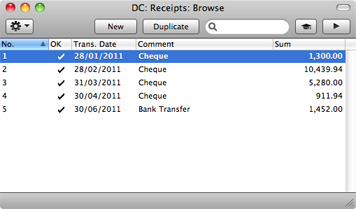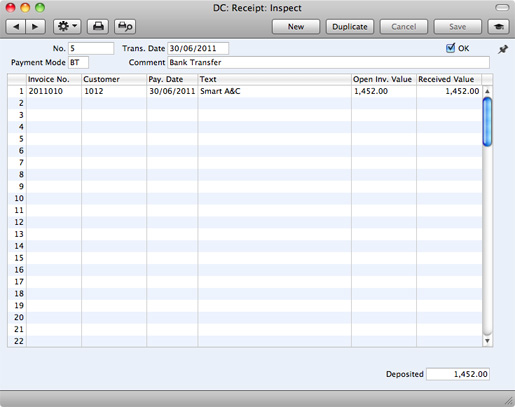Entering a Receipt
Open the Receipt register by clicking the [Receipts] button in the Master Control panel or using the relevant keyboard shortcut (for example, ⌘-2 in Standard Invoicing or ⌘-3 in Standard Contracts, depending on the position of the icon in the Master Control panel). The 'Receipts: Browse' window is opened, showing Receipts already entered.

Receipts are numbered consecutively. In the list, the Receipt Number is followed by a check mark if the Receipt is approved, by the Date, any Comment and the total value of the Receipt.
To enter a new Receipt, click [New] in the Button Bar or use the ⌘-N keyboard shortcut. Alternatively, select a Receipt similar to the one you want to enter and click [Duplicate] on the Button Bar.
The 'Receipt: New' window is opened, empty if you clicked [New] or containing a duplicate of the highlighted Receipt. In the case of the duplicate, the Transaction Date of the new Receipt will be the current date, not the date of the duplicated Receipt. Complete the Receipt record as described below, then save it using the [Save] button and close the window by clicking the close box. Then, close the browse window using the close box again.

First a run-through of the fields.
- No.
- The Receipt Number of a new Receipt is provided automatically by Standard Invoicing. You may change this number, but not to one that has already been used.
- The Receipt Number sequence will start at 1 and continue consecutively. If you want the sequence to start from another number, change the Receipt Number of a Receipt before saving it for the first time. The sequence will continue from that point.
- Trans. Date
- Paste Special
Choose date
- The date of the Receipt.
- OK
- You can approve a Receipt by checking this box. When you click [Save] to save the Receipt, the Sales Ledger will be updated and no further modifications to the Receipt will be possible.
- References in these web pages to approved Receipts are to Receipts whose OK box has been checked (i.e. an approved Receipt is one that is no longer a Draft).
- Payment Mode
- Paste Special
Payment Modes setting
- The Payment Mode is the method of payment (e.g. cheque, credit card or cash).
You can enter payments from different Customers against different Invoices in a single Receipt. However, you cannot enter payments with different Payment Modes.
The first record listed in the Payment Modes setting will be offered as a default.
- Comment
- Default taken from
Payment Mode
- This text is taken from the Payment Modes setting. You can change it if necessary.
Use the grid area that takes up most of the screen to list the Invoices being paid by the Receipt. You can receive payment against several Invoices in a single Receipt record, but all payments on a single Receipt must use the same Payment Mode. The Payment Mode reflects the payment method (i.e. cheque, cash or credit card): you can record every payment received in a single day and paid into a particular bank or cash account using a single Receipt record.
To add a row to a Receipt, click in any field in the first blank row and enter appropriate text. To remove a row, click on the row number on the left of the row and press the Backspace key. To insert a row, click on the row number where the insertion is to be made and press Return.
You can bring several Invoices into a Receipt at once by opening the 'Invoices: Browse' or 'Paste Special' windows, selecting a range of Invoices by clicking while holding down the Shift key, and then dragging them to the Inv. No. field in the first empty Receipt row. You can also copy a list of Invoice Numbers in a spreadsheet or word processor and paste them in the Inv. No. field in the first empty row.
- Inv. No.
- Paste Special
Open, approved Invoices, Invoice register
- The number of the Invoice being paid. When you enter an Invoice Number, the Open Invoice Value (the amount outstanding) will be shown in the Open Inv. Val field, and this figure will also be brought in to the Received Value field as a default.
- Note that when you use 'Paste Special', only unpaid Invoices will appear in the selection list. However, if you have saved a Receipt without approving it (i.e. the Receipt is a Draft), the Invoice(s) in that Receipt will be treated as unpaid and thus will continue to be included in the 'Paste Special' list. It is therefore recommended that you do not leave Receipts as unapproved for too long, to minimise the risk of quoting Invoices in Receipts more than once.
- Customer
- Default taken from Invoice
- The Customer Number will be placed here automatically when you enter an Invoice Number.
- Pay. Date
- The date when the payment was made. This date must be the same as the Transaction Date (in the header) and cannot be changed independently.
- Text
- The Customer's Name will appear here when you enter the Invoice or Customer Number. You can change this text if necessary.
- Open Inv. Val.
- The outstanding amount of the Invoice being paid. This value cannot be changed.
- Received Val
- Default taken from
Open Invoice Value
- The amount paid. You can change the default figure in the event of partial payments or overpayments.
Footer
- Deposited
- The sum of the Received Values: the total for this Receipt.
---
In this chapter:
Go back to home pages for:
